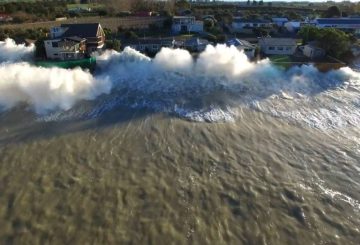Isinasaalang-alang mo ba ang pagbilang ng mga balyena bilang isang masayang aktibidad sa taglamig? Ang Great Kaikōura Whale Count sa New Zealand ay naghahanap ng mga boluntaryo mula 27 Hunyo hanggang 10 Hulyo. Sinimulan ng Kaikōura Ocean Research Institute (KORI) ang proyektong ito noong 2020 nang sarado ang mga kumpanya ng paglalakbay dahil sa mga paghihigpit sa Covid-19.
Ang layunin ng proyekto ay upang tantyahin ang bilang ng mga balyena na lumipat sa pagitan ng kanilang mga lugar ng pagpapakain sa Timog Karagatan malapit sa Antarctica at ang kanilang mga lugar ng pag-aanak sa mas mainit na klima. Ang bilang ay huminto sa loob ng isang taon dahil sa kakulangan ng pondo, ngunit kinumpirma ng direktor ng KORI na si Dr. Jody Weir na naka-secure ang pondo mula sa Kaikōura District Council.
Halos 200 mga boluntaryo mula sa buong bansa ang tumutulong sa taunang bilang. Sa loob ng tatlong taon na isinagawa nito, napansin ni KORI ang pagtaas sa bilang ng mga balyena, kabilang ang mga humpbacks, at isang malaking bilang ng mga buga. “Sa pinakamahusay na araw sa 2022, binibilang namin ang 40 humpbacks at mayroong orca, sperm whales at blue whales,” sabi ni Dr. Weir.
Noong Mayo 2020, ang mga lokal na operator ng turismo na WhaleWatch at Dolphin Encounter ay sarado dahil sa Covid, ngunit lumilipat pa rin ang mga balyena. Ang mga taong hindi nagtatrabaho at tumatanggap ng mga subsidyo ng gobyerno ay ipinadala upang tulungan, kasama ang mga turista na natigil sa lugar.
Nakatanggap ang KORI ng grant mula sa konseho upang pondohan ang ilang mga internship, na nagpapahintulot sa mga estudyante na tumulong sa pagpapatakbo ng mga inisyatibo, kabilang Araw-araw, mula Hunyo 27 hanggang 10 Hulyo, makikita ng mga boluntaryo ang mga balyena sa istasyon ng monitoring sa Kaikōura Peninsula mula 10am hanggang 4pm, kung pahintulot ang panahon.
Isang session ng pagsasanay ang gaganapin sa Kaikoura Museum sa 27 Hunyo, at magkakaroon ng mga libreng kaganapan upang ipagdiwang ang mga balyena sa Sabado, 29 Hunyo, at Linggo, 7 Hulyo. Para sa karagdagang impormasyon, maaari kang makipag-ugnay sa gkwc2024@gmail.com.




























































